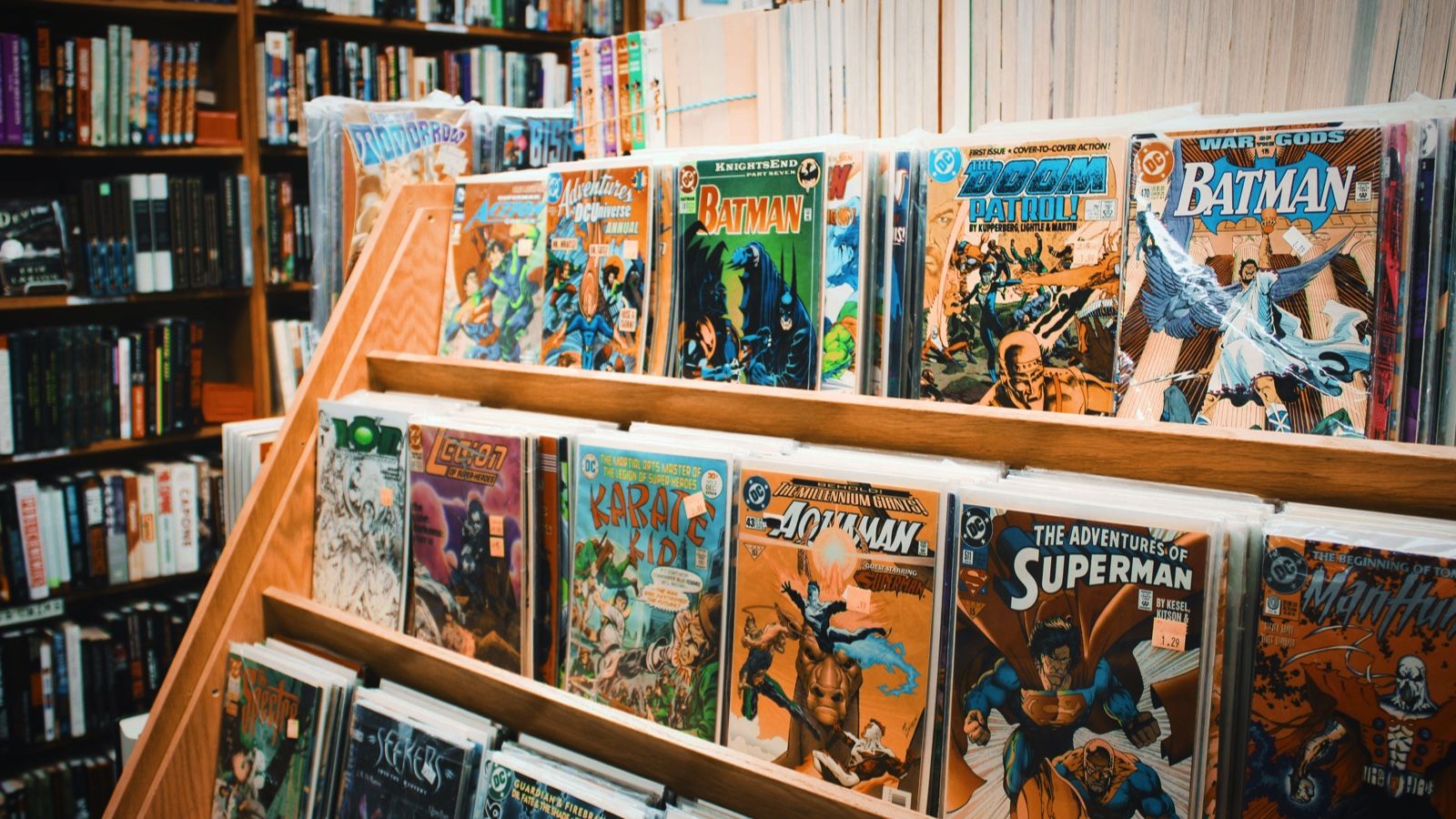DC Comics Still Has a Gender Problem
DC Comics has a problem. And I’m not referring to the recent “bloodbath” of layoffs at Warner Brothers that included much of the editorial staff at DC. Nor am I referring to the latest round of sexual misconduct accounts in the industry in which numerous creators, many of whom have worked for DC, were alleged to have harassed, groomed, and manipulated coworkers and fans. I’m not even referring to the fact that DC is continuing to publish work by some of these creators, most notably Warren Ellis, though it’s relevant.
No, today I want to talk about the massive gender disparity in their hiring. Again. Still. Yes, really.
2020 has been a funny year for DC, and not just because it’s an endless apocalyptic hellscape for the whole planet. They’ve had numerous anniversaries, some quite impressive (80 years of Robin, Green Lantern, Catwoman, and the Joker!) and some pretty much manufactured (Wonder Woman #750 and Flash #750, numbers achieved only if you disregard numerous reboots and relaunches; Detective Comics #1027, which is a thousand issues later than Batman’s first appearance in Detective Comics #27, so…not anything). And they’ve capitalized on these events with special anthology issues that boast a higher-than-usual page count and long lists of creator names.
These anniversary issues are legitimately a lot of fun, especially if you’re a fan of comics history like I am. But they also offer a quick snapshot of who exactly is writing and drawing for DC comics. And those numbers are awfully revealing. Let’s take a deep dive.
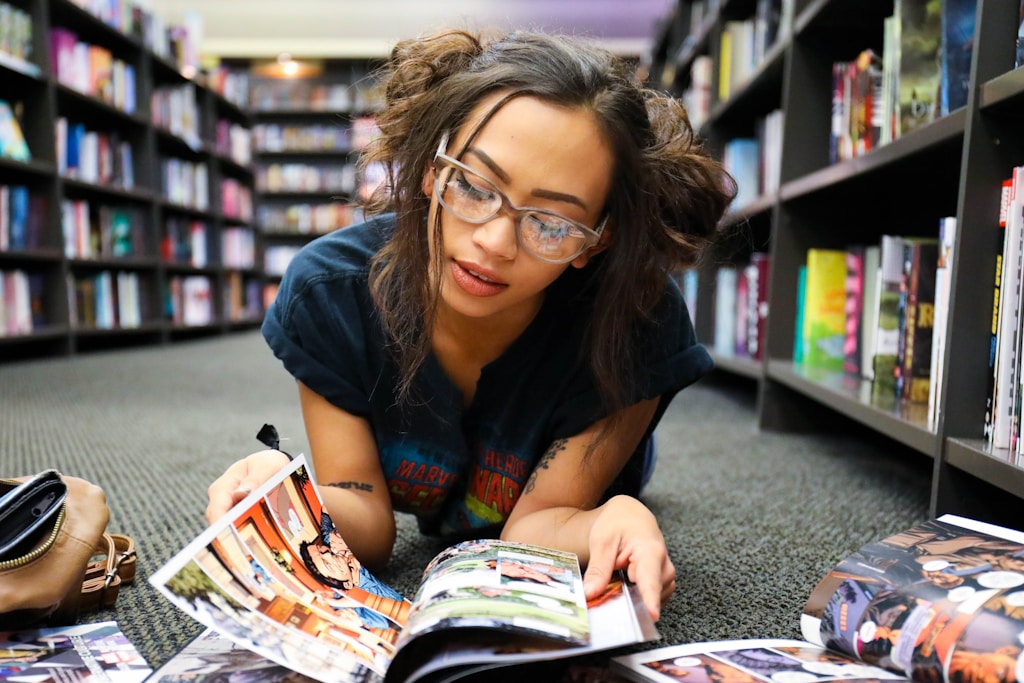
A few things to note about these stats before we get started:
1. I’m only looking at gender here, but from a glance the creative teams are not particularly racially diverse, especially the writers. I would imagine the representation when looking at sexuality, religion, and ability level is not great either.
2. I looked at eight projects, all of which have 40–70 named creators associated with them, and only noted one nonbinary creator. If I have missed any other nonbinary creators, I apologize and will happily take corrections, but it’s also worth noting that not everyone is out about their gender, so these stats are of necessity largely based on my assumptions from names and photos and should be taken with a grain of salt.
3. Many gender analyses of comics only look at writers and pencillers, but I included inkers, colorists, letterers, cover artists, and pinup artists, because they all worked on these comics and should get the credit…and they all got paid to do so, which is important to remember when we’re talking about the jobs women aren’t getting.
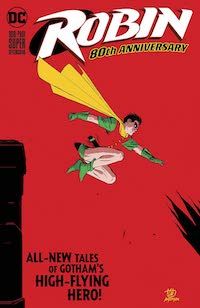
The first anniversary issue to publish this year was the Robin 80th Anniversary 100-Page Super Spectacular, back in March. All of the 80th Anniversary issues contain 10 stories, plus a varying number of pinups. Out of the ten stories in the Robin issue, seven have no female creators at all. Two are written by women; one has a female penciller. One of the pinups was drawn by two women. That makes a grand total of five women out of 48 creators, or 10%.
It’s also worth noting that many of the stories in the anniversary issues were written or drawn by creators with a history with the character in question, which is charming. However, it further highlights the historical (and not so historical) lack of women on these books. In the Robin issue, the only story not written by someone strongly associated with its protagonist is the Stephanie Brown story, which was written by Amy Wolfram. While I’m happy to see the female Robin get a female writer, it’s notable that she’s never had one before. (But if we’re going to talk about the sexism Steph has been subjected to over the years, we’ll be here all day.)

We got three anniversary issues in June: Catwoman, the Joker, and Green Lantern. The Catwoman 80th Anniversary 100-Page Super Spectacular had by far the most balanced gender ratio of the anniversary issues—unsurprisingly, considering the gender of its star—with only four out of ten stories with no female creators at all, and a whopping 12 women (yes, I’m rolling my eyes) in the book, including two writers and two pencillers. With 48 creators total, that’s a solid 25%.
Conversely, The Joker 80th Anniversary 100-Page Super Spectacular had fairly dire stats, also unsurprisingly, with eight out of ten stories featuring no female creators at all, and a single female penciller. A female colorist and two pinups from women give us four female creators out of 49 total, or 8%.
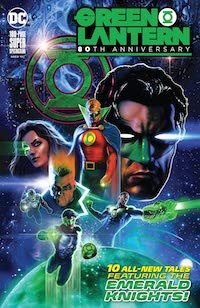
Finally, the Green Lantern 80th Anniversary 100-Page Super Spectacular also had eight stories with no female creators, but a better average overall, with two female writers and a female penciller. The women on this book were overwhelmingly assigned to (or perhaps pitched for?) the single main continuity female Green Lantern, Jessica Cruz: her story has a female writer, penciller, and letterer, and her pinup was drawn and colored by two women. With a female writer on the John Stewart story and a female artist on the Kyle Rayner pinup, that’s seven women out of 54 creators, or juuust under 13%. (Side note: unless I’m mistaken, N. K. Jemisin—who does not have a story in this issue—is the first woman to write a Green Lantern book. In 80 years. Yeah.)
So much for the anniversary issues. Let’s take a look at some of the other special issues this year!
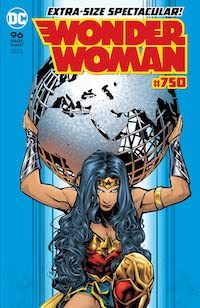
In January, DC published Wonder Woman #750, which they then released as a deluxe hardcover in August. This one is interesting, folks. It has by far the most women both in absolute numbers and by percentage, which is fitting, since it’s, you know, Wonder Woman. But.
There are nine stories in the issue, not counting the reprint of Diana’s first appearance in All Star Comics #8 by William Moulton Marston and H. G. Peter, since I don’t think it’s fair to hold DC of today accountable for the staffing of DC in 1941. Two stories have all-male creative teams; one has a nonbinary writer but no women. One of those all-male stories is the conclusion to the then-current arc in the series, meaning that the regular Wonder Woman book had no women on the creative team. (You might be wondering, after all the talk of all-male stories, whether there are any in any of these comics with no men. The answer is of course not. There’s at least one male creator on every single story in every single comic I’m discussing.)
There are five female writers on the book and four female pencillers. According to the table of contents, there are 17 women on the book out of a total of 48 creators, or 35%. However, this number is misleading, because it doesn’t take into account the 25 (!) variant covers DC created for this issue, all of which are included in the deluxe hardcover edition (and all of which were of course paying jobs). Aside from that number of variants being straight-up ridiculous, there are 20 men on those variants and 5 women, which means that the percentage of female creators on this project drops to just under 30%. And even there the number is misleading, because several male artists have multiple variants (Jim Lee and J. Scott Campbell each have four), while the only female artist on more than one variant is Sabine Rich, co-credited on J. Scott Campbell’s pinups. There aren’t just more male artists; the male artists get more work.

The other #750 is Flash #750. Like Wonder Woman, this published as an extra-sized single issue first and then as a deluxe hardcover edition, in March and July respectively. The single issue contained six stories by 32 creators (again, not counting the reprinted first appearance of Barry Allen, which I don’t hold the current DC editors accountable for). Folks, this one surprised me—I would have thought the Joker would boast the worst stats, but no, it’s our friends from Central and Keystone City. Not a single creator in the issue itself was a woman. (And like Green Lantern, I don’t believe a woman has ever been the regular writer or artist on the Flash, though Gail Simone did write the Walmart-only minis, The Flash Giant.) The hardcover, which includes the variant covers, does have a single variant by Nicola Scott and Anette Kwok, plus another ten male artists on variants, for a total of 2 women out of 44 creators, or 4%. Utterly shameful.
Then there’s Detective Comics #1027, which publishes this September. It contains 12 stories, eight of which have no women. There are two female writers and one female penciller. There are an astonishing 70 creators credited, eight of whom are women: a mere 11%.

While we’re here, I also want to talk about the current storyline in Legion of Super-Heroes, “Trial of the Legion of Super-Heroes,” which will stretch over issues #8 and 9, publishing in September and October. We don’t have the full credits, as the second issue isn’t out yet, but we do know the writer (Brian Michael Bendis) and all of the pencilers, since Bendis proudly shared a poster listing the whopping 43 artists who will be participating; we also know the colorist and letterer for #8, and there’s a variant cover by Dustin Nguyen. That gives us seven known female creators out of a total of 47, or 14%. But I suppose this isn’t too shocking from Bendis, whose pop-up imprint at DC, Wonder Comics, launched with four books but not a single female writer or penciller.
To recap:
- Robin: 5 women, 10%
- Catwoman: 12 women, 25%
- Joker: 4 women, 8%
- Green Lantern: 7 women, 13%
- Wonder Woman: 22 women, 30%
- Flash: 2 women, 4%
- Detective Comics: 8 women, 11%
- Legion: 6 women, 14%
Overall, these massive projects average out to just over 14% female.
As a reminder, if for some reason that’s needed: the Earth’s population is approximately 50% female.
I used the word shameful before, and I stand by that. DC should be ashamed of these numbers. They should be embarrassed by them. They should see this as a very real and very obvious problem that they need to put a serious effort into solving.
(And let’s throw out the idea right here that women just aren’t interested in comics in general and superhero comics in particular. The state of market research in the industry is dire, but various analyses over the past five years or so repeatedly indicate that somewhere between 30 and 45% of comic book readers are women, with even higher percentages indicating interest in superheroes in general—i.e. a potential growth market if the industry would only cater to it.)
Obviously, the wildly disproportionate nature of these numbers is a problem on its own. But let’s dig into what they indicate a bit more.

First of all, it’s clear that women are overwhelmingly being hired to write and draw women. The Wonder Woman and Catwoman books have by far the highest percentages of female creators on them. On books where there is one solitary female character (Stephanie Brown, Jessica Cruz), women worked on that character. Now, don’t get me wrong—I think having female creators on a female character confers depth and authenticity that men often struggle with, because our male-focused culture doesn’t often require men to empathize with women, just as Black writers and artists often do more justice to Black characters than white writers and artists, gay writers and artists do more justice to gay characters than straight writers and artists, etc. I’m not saying we should take the women off the female characters. But they still don’t come anywhere close to 50% of the creators on those characters, let alone a majority the way men massively outnumber the women on, say, the Joker and Flash books.
Male characters also massively outnumber female ones in terms of which characters DC gives books to, which means that if women are mostly assigned to work on women, the opportunities are already smaller to begin with. There are four boy Robins and one girl. There are six male Green Lanterns in main DC continuity and one woman. A 1/3 or 1/4 chance to write or draw one out of five or seven characters isn’t great odds. And the picture doesn’t look any better outside of these anniversary issues. As of the latest round of cancelations, there are only two female characters at DC with ongoing books: Wonder Woman and Catwoman. No Batgirl, no Supergirl, no Harley Quinn; no women of color.

Furthermore, even when women do get hired to work on (almost exclusively) female characters, there are indications that they are not treated with the respect and inclusion their male colleagues receive. During the latest round of reports of sexual misconduct in the industry, other stories came out, ones that weren’t about sexual harassment or grooming, but professional marginalization and exclusion. Mairghread Scott, who wrote Batgirl from 2018–2019, posted a series of tweets detailing being excluded from multiple Bat-family summits. These are meetings during which writers and editors hash out future storylines, which, given the way the DC universe works, are all intertwined. By deliberately excluding a woman from these meetings, DC not only potentially opened themselves up to a lawsuit, but actively made her job exponentially harder, since she didn’t know what the rest of the writers were planning and had to continually revise her own book to fit in with what the male writers were doing. Eventually, Scott said, the amount of extra work for no extra pay made it unfeasible to continue working for DC. (Her successor on the book, Cecil Castellucci, confirmed that she was likewise excluded.)
But of course, it’s easy to exclude women from a meeting when there’s only one. If there was more gender parity at DC, it would be a lot harder to get away with leaving the women out of the summits.
And then, of course, there’s the elephant in the room: sexual harassment. We know that harassment is ubiquitous across the industry, not just at DC—but we also know that historically it’s been codified into DC’s editorial structure in a way that may also happen at other publishers (Dark Horse springs to mind), but we don’t necessarily have the public-facing evidence. I’m speaking, of course, of Eddie Berganza, who worked at DC for 25 years and rose to the level of executive editor despite being repeatedly reported for sexual harassment and assault, and was only fired after a Buzzfeed expose in 2017. During his tenure, the rumor was that women could not be hired to work in the Superman office, which encompassed Wonder Woman as well as all of the Super books, because DC knew that if he worked with a woman, he would harass her.
Another reminder: basing your hiring practices on gender is illegal in all 50 states.
DC’s dirty laundry has been so thoroughly aired in this regard that you might think they’d be doing everything they can to avoid at least the appearance of sustained, systemic discrimination. And yet three years after Berganza’s firing, I’m looking at that 14% figure and wondering why I’m surprised. We are still hearing stories about assault, harassment, exclusion, and grooming from DC employees and freelancers. DC is still working with many of those named. I have been kind and not tallied up how many men accused of sexual misconduct contributed to the anthology books I’m focusing on in this piece, mostly because they would have been hired and many of the stories in the can before the latest round of allegations in June, but they’re there. And given how much of an open secret Berganza was, I find it hard to believe that no one at DC knew anything sketchy about any of these men.
These issues are related not just because DC may have deliberately not hired women to avoid being sued when those women were sexually harassed, rather than firing the harassers, but because the dearth of women makes it easier for sexual predators to do what they do. If you’re a woman who only has a 14% shot at your dream job (or any other marginalized creator, and god help you if you have several intersecting marginalizations), you’re less likely to speak out if you are subjected to sexual harassment or other misconduct, because the boys’ club that is the comic book industry punishes women for rocking the boat. Especially if you’re a freelancer with no guaranteed employment after you hand in your next assignment.
Which brings me to two questions:
1. What in god’s name is the state of HR at DC? At WB? As someone with a day job in the corporate world, this is just unreal to me. I understand that HR exists to protect the company, not the employees and certainly not the freelances, but how is no one over there concerned about the potential lawsuits stacking up?
2. Are any of the men working on these books saying a word?
Back in June, a graphic started making the rounds on Twitter called the #ComicsPledge. It was titled “Men In Comics Say No,” and included promises not to harass anyone and to be allies for women and “all people of marginalized genders and sexes.” The Comics Pledge got a lot of pushback, not just for its awkwardly over-thought language that still failed to be inclusive (men, both cis and trans, can also be harassed, and nonbinary people aren’t a bonus extra-marginalized kind of women), but because it was a completely empty promise. The most egregious bad actor can post any graphic they like to their Twitter account, and sharing a graphic and hashtag is no substitute for doing the work.
But when I look at the men who shared it, I see big, successful names in the industry, many of whom appear in these anthologies: Tom King. Scott Snyder. Joshua Williamson. Jeff Lemire. James Tynion IV. Did any of them ask how many women would be participating in these books? How about luminaries like Brian Michael Bendis, like Matt Fraction, like Brian Azarello? Did Geoff Johns or Ed Brubaker say a word? Greg Rucka or Chip Zdarsky? Some of these men have built careers off of writing strong female characters for largely female audiences. (Some of those characters have starred in TV shows that made a hell of a lot of money.) Did a single one of the 216 men credited across these books ever ask where the women were?
Maybe they did. Many of these men have created work that means a lot to me. I’d like to believe they spoke up.
Either way, DC clearly has massive ground to cover to bring their hiring practices anywhere close to in line with their readership, let alone the actual statistics of the real world. Can they do it?
Back in 2011, when DC announced the creative lineup for their New 52 reboot, fans noticed that the percentage of female creators (looking only at pencillers and writers) had dropped precipitously from an already dreadful 12% to a shocking 1%. Then co-publisher Dan DiDio, who is no longer with DC Comics, infamously berated fans who asked him about this at conventions, but we didn’t shut up. We continued to demand more women on DC’s comics, and that number rose. Tim Hanley, who tracks representation of women and nonbinary creators at Marvel and DC every month on his blog, reports that just this February, 40% of DC’s output included a female creator, a high water mark for the publisher. (Note that this is the percentage of books with a female creator on them, not the percentage of female creators out of total creators, which is what I have been analyzing.)
DC’s new senior vice president, Daniel Cherry III, recently took to LinkedIn to emphasize his commitment to serving an “increasingly diverse global fanbase” – which, one would assume, means increasingly diverse hiring as well. Looking at these numbers, and DC’s shocking history in regards to sexual harassment and gender-based exclusion, it’s clear that they have a lot of ground to make up in that department—and again, these statistics don’t take into account any other axes of marginalization, which likely aren’t any better and in many cases worse. But as fans, we can hope that Cherry’s words aren’t just lip service and that he does in fact take the company in a more inclusive, forward-thinking direction. We can hope that the men who were so eager to tweet about their support actually say something to the people in a position to change the state of the industry. And if things don’t change, we know that fan pressure works, because it has before.
Your move, DC.
